Developing Professional Practice Report - CIPD 5DVP Assessment, 2019
VerifiedAdded on 2022/08/25
|18
|4736
|27
Report
AI Summary
This report analyzes the CIPD professional map and its application within HR, exploring the importance of professionalism, core values, and evidence-based practices. It delves into team development theories, including Tuckman and Belbin's models, and examines conflict resolution methods like competing and collaborating approaches. The report also covers project management techniques, their role in problem-solving, and the development of a professional development plan (PDP). The content includes an introduction to the CIPD professional map, an analysis of group dynamics and team development, exploration of conflict resolution strategies, and the application of project management techniques. The report concludes with a summary of developmental needs and a reflection on the PDP, offering valuable insights into professional development within the HR context.
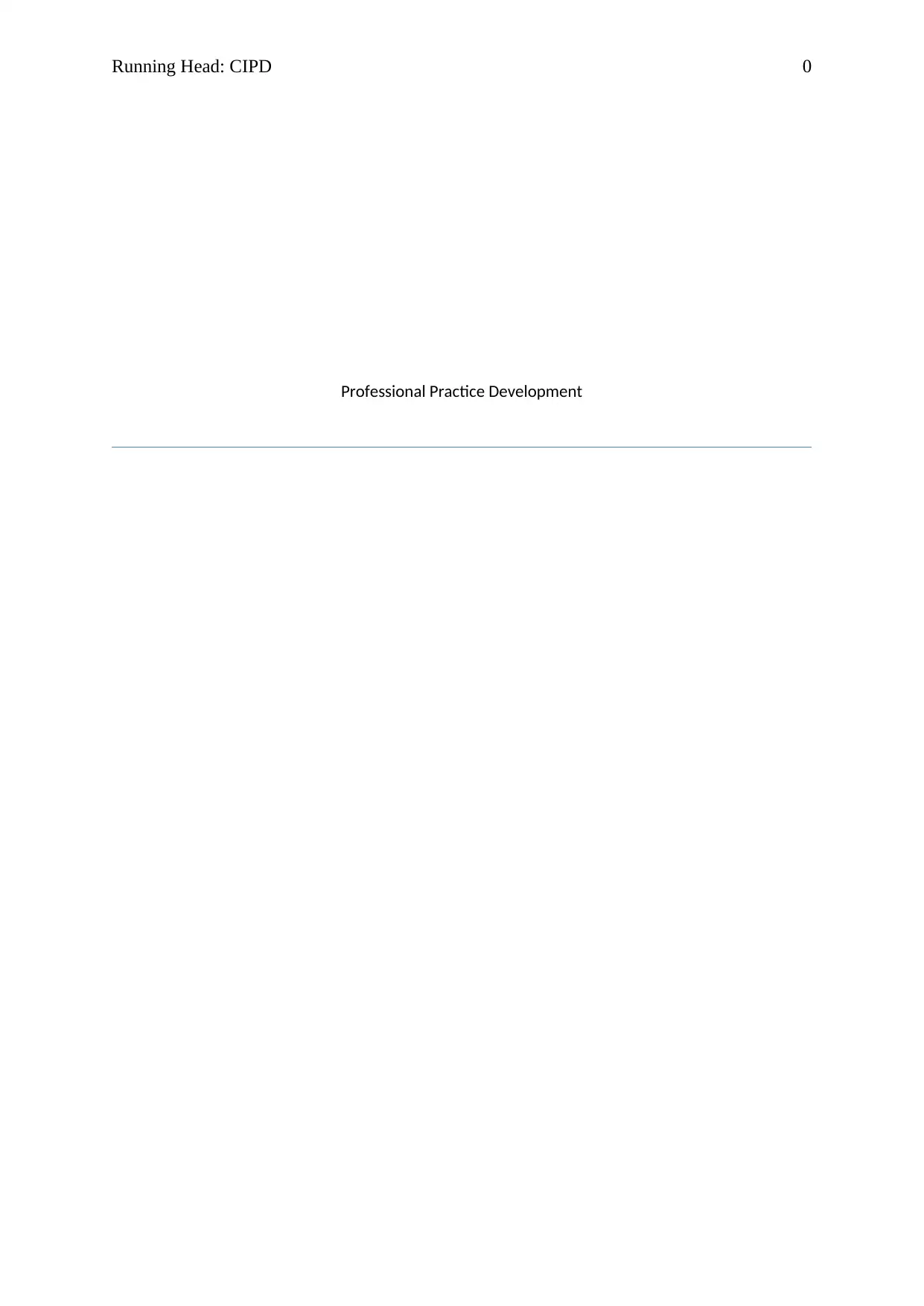
Running Head: CIPD 0
Professional Practice Development
Professional Practice Development
Paraphrase This Document
Need a fresh take? Get an instant paraphrase of this document with our AI Paraphraser
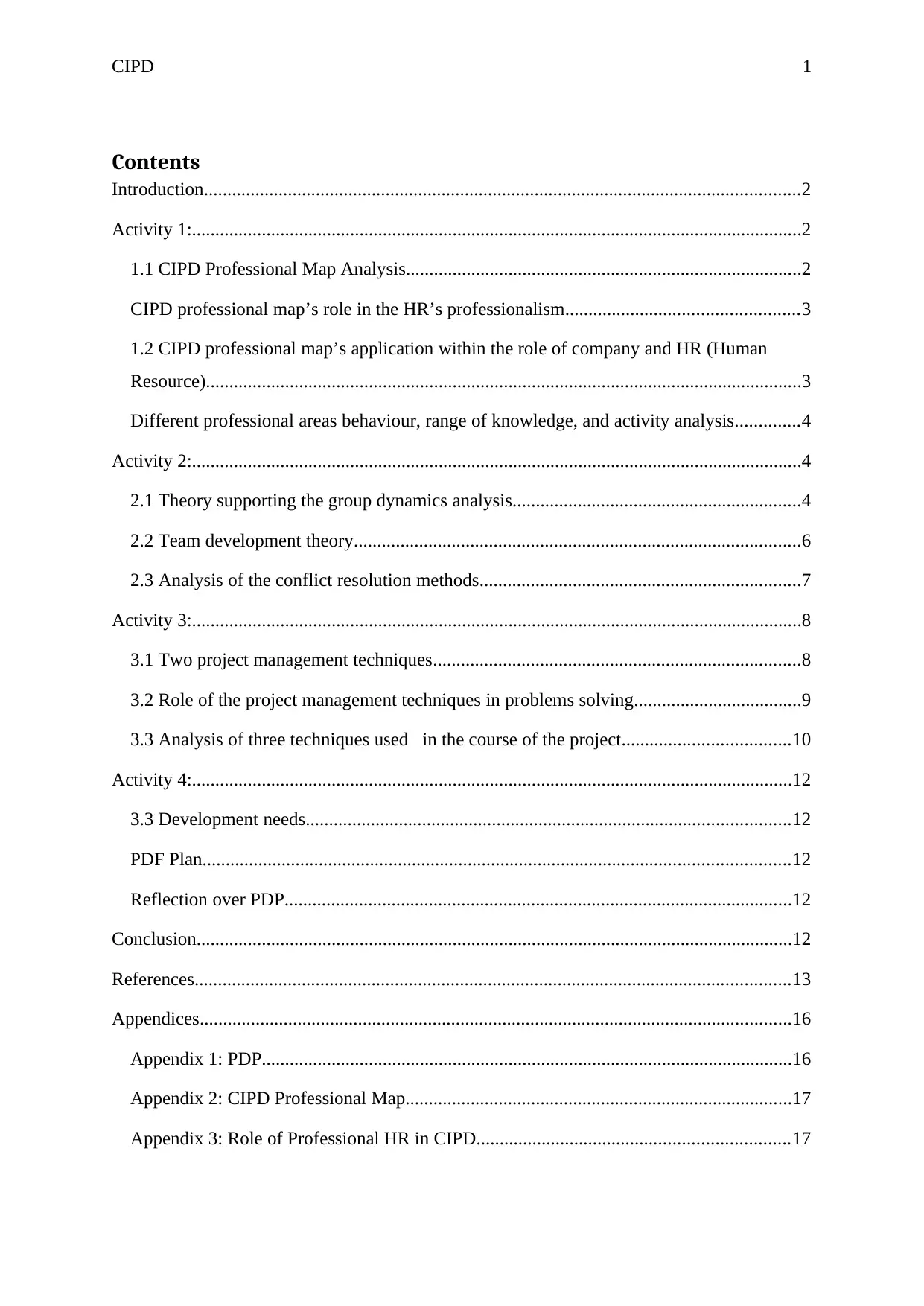
CIPD 1
Contents
Introduction................................................................................................................................2
Activity 1:...................................................................................................................................2
1.1 CIPD Professional Map Analysis.....................................................................................2
CIPD professional map’s role in the HR’s professionalism..................................................3
1.2 CIPD professional map’s application within the role of company and HR (Human
Resource)................................................................................................................................3
Different professional areas behaviour, range of knowledge, and activity analysis..............4
Activity 2:...................................................................................................................................4
2.1 Theory supporting the group dynamics analysis..............................................................4
2.2 Team development theory................................................................................................6
2.3 Analysis of the conflict resolution methods.....................................................................7
Activity 3:...................................................................................................................................8
3.1 Two project management techniques...............................................................................8
3.2 Role of the project management techniques in problems solving....................................9
3.3 Analysis of three techniques used in the course of the project....................................10
Activity 4:.................................................................................................................................12
3.3 Development needs........................................................................................................12
PDF Plan..............................................................................................................................12
Reflection over PDP.............................................................................................................12
Conclusion................................................................................................................................12
References................................................................................................................................13
Appendices...............................................................................................................................16
Appendix 1: PDP..................................................................................................................16
Appendix 2: CIPD Professional Map...................................................................................17
Appendix 3: Role of Professional HR in CIPD...................................................................17
Contents
Introduction................................................................................................................................2
Activity 1:...................................................................................................................................2
1.1 CIPD Professional Map Analysis.....................................................................................2
CIPD professional map’s role in the HR’s professionalism..................................................3
1.2 CIPD professional map’s application within the role of company and HR (Human
Resource)................................................................................................................................3
Different professional areas behaviour, range of knowledge, and activity analysis..............4
Activity 2:...................................................................................................................................4
2.1 Theory supporting the group dynamics analysis..............................................................4
2.2 Team development theory................................................................................................6
2.3 Analysis of the conflict resolution methods.....................................................................7
Activity 3:...................................................................................................................................8
3.1 Two project management techniques...............................................................................8
3.2 Role of the project management techniques in problems solving....................................9
3.3 Analysis of three techniques used in the course of the project....................................10
Activity 4:.................................................................................................................................12
3.3 Development needs........................................................................................................12
PDF Plan..............................................................................................................................12
Reflection over PDP.............................................................................................................12
Conclusion................................................................................................................................12
References................................................................................................................................13
Appendices...............................................................................................................................16
Appendix 1: PDP..................................................................................................................16
Appendix 2: CIPD Professional Map...................................................................................17
Appendix 3: Role of Professional HR in CIPD...................................................................17
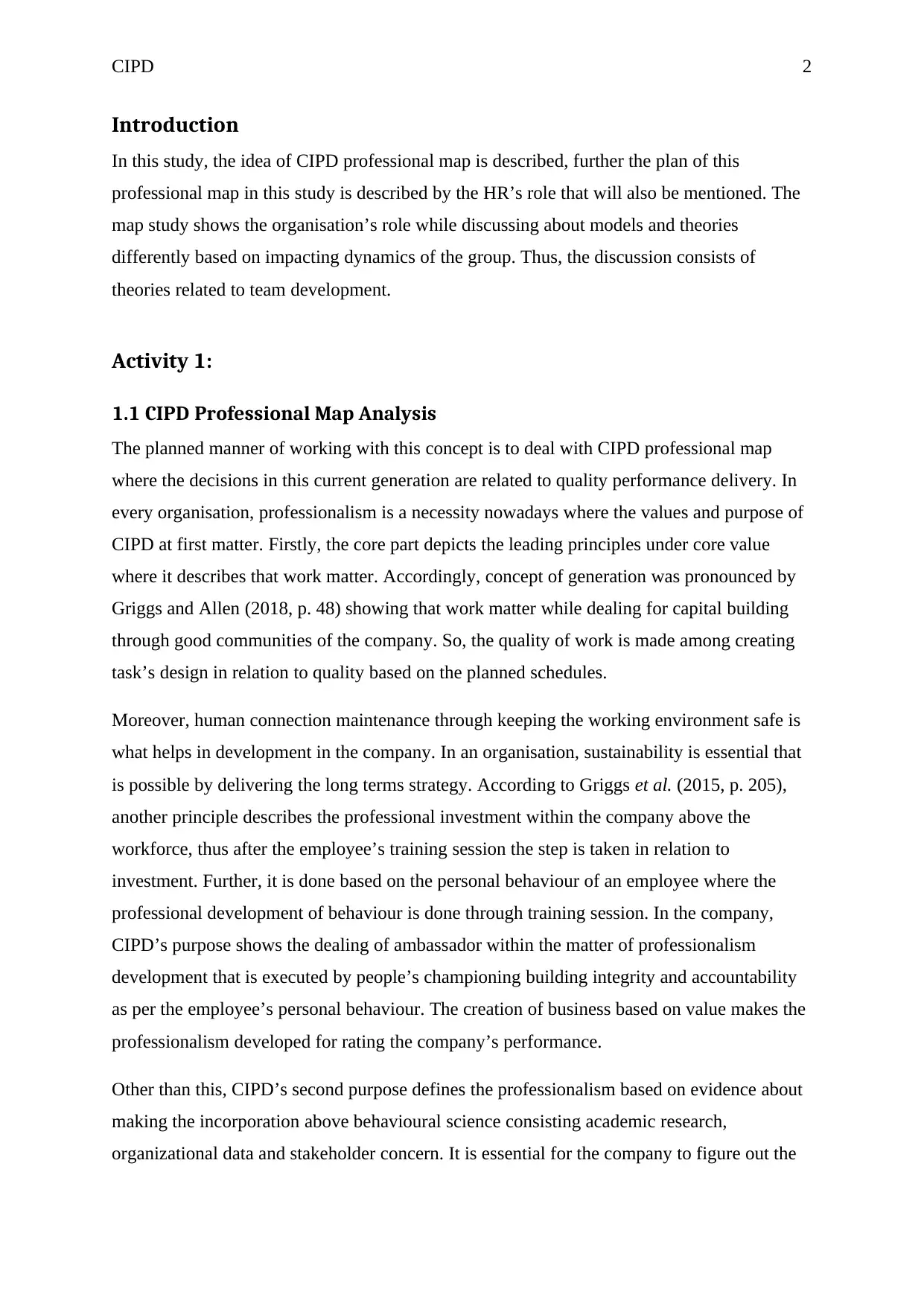
CIPD 2
Introduction
In this study, the idea of CIPD professional map is described, further the plan of this
professional map in this study is described by the HR’s role that will also be mentioned. The
map study shows the organisation’s role while discussing about models and theories
differently based on impacting dynamics of the group. Thus, the discussion consists of
theories related to team development.
Activity 1:
1.1 CIPD Professional Map Analysis
The planned manner of working with this concept is to deal with CIPD professional map
where the decisions in this current generation are related to quality performance delivery. In
every organisation, professionalism is a necessity nowadays where the values and purpose of
CIPD at first matter. Firstly, the core part depicts the leading principles under core value
where it describes that work matter. Accordingly, concept of generation was pronounced by
Griggs and Allen (2018, p. 48) showing that work matter while dealing for capital building
through good communities of the company. So, the quality of work is made among creating
task’s design in relation to quality based on the planned schedules.
Moreover, human connection maintenance through keeping the working environment safe is
what helps in development in the company. In an organisation, sustainability is essential that
is possible by delivering the long terms strategy. According to Griggs et al. (2015, p. 205),
another principle describes the professional investment within the company above the
workforce, thus after the employee’s training session the step is taken in relation to
investment. Further, it is done based on the personal behaviour of an employee where the
professional development of behaviour is done through training session. In the company,
CIPD’s purpose shows the dealing of ambassador within the matter of professionalism
development that is executed by people’s championing building integrity and accountability
as per the employee’s personal behaviour. The creation of business based on value makes the
professionalism developed for rating the company’s performance.
Other than this, CIPD’s second purpose defines the professionalism based on evidence about
making the incorporation above behavioural science consisting academic research,
organizational data and stakeholder concern. It is essential for the company to figure out the
Introduction
In this study, the idea of CIPD professional map is described, further the plan of this
professional map in this study is described by the HR’s role that will also be mentioned. The
map study shows the organisation’s role while discussing about models and theories
differently based on impacting dynamics of the group. Thus, the discussion consists of
theories related to team development.
Activity 1:
1.1 CIPD Professional Map Analysis
The planned manner of working with this concept is to deal with CIPD professional map
where the decisions in this current generation are related to quality performance delivery. In
every organisation, professionalism is a necessity nowadays where the values and purpose of
CIPD at first matter. Firstly, the core part depicts the leading principles under core value
where it describes that work matter. Accordingly, concept of generation was pronounced by
Griggs and Allen (2018, p. 48) showing that work matter while dealing for capital building
through good communities of the company. So, the quality of work is made among creating
task’s design in relation to quality based on the planned schedules.
Moreover, human connection maintenance through keeping the working environment safe is
what helps in development in the company. In an organisation, sustainability is essential that
is possible by delivering the long terms strategy. According to Griggs et al. (2015, p. 205),
another principle describes the professional investment within the company above the
workforce, thus after the employee’s training session the step is taken in relation to
investment. Further, it is done based on the personal behaviour of an employee where the
professional development of behaviour is done through training session. In the company,
CIPD’s purpose shows the dealing of ambassador within the matter of professionalism
development that is executed by people’s championing building integrity and accountability
as per the employee’s personal behaviour. The creation of business based on value makes the
professionalism developed for rating the company’s performance.
Other than this, CIPD’s second purpose defines the professionalism based on evidence about
making the incorporation above behavioural science consisting academic research,
organizational data and stakeholder concern. It is essential for the company to figure out the
⊘ This is a preview!⊘
Do you want full access?
Subscribe today to unlock all pages.

Trusted by 1+ million students worldwide
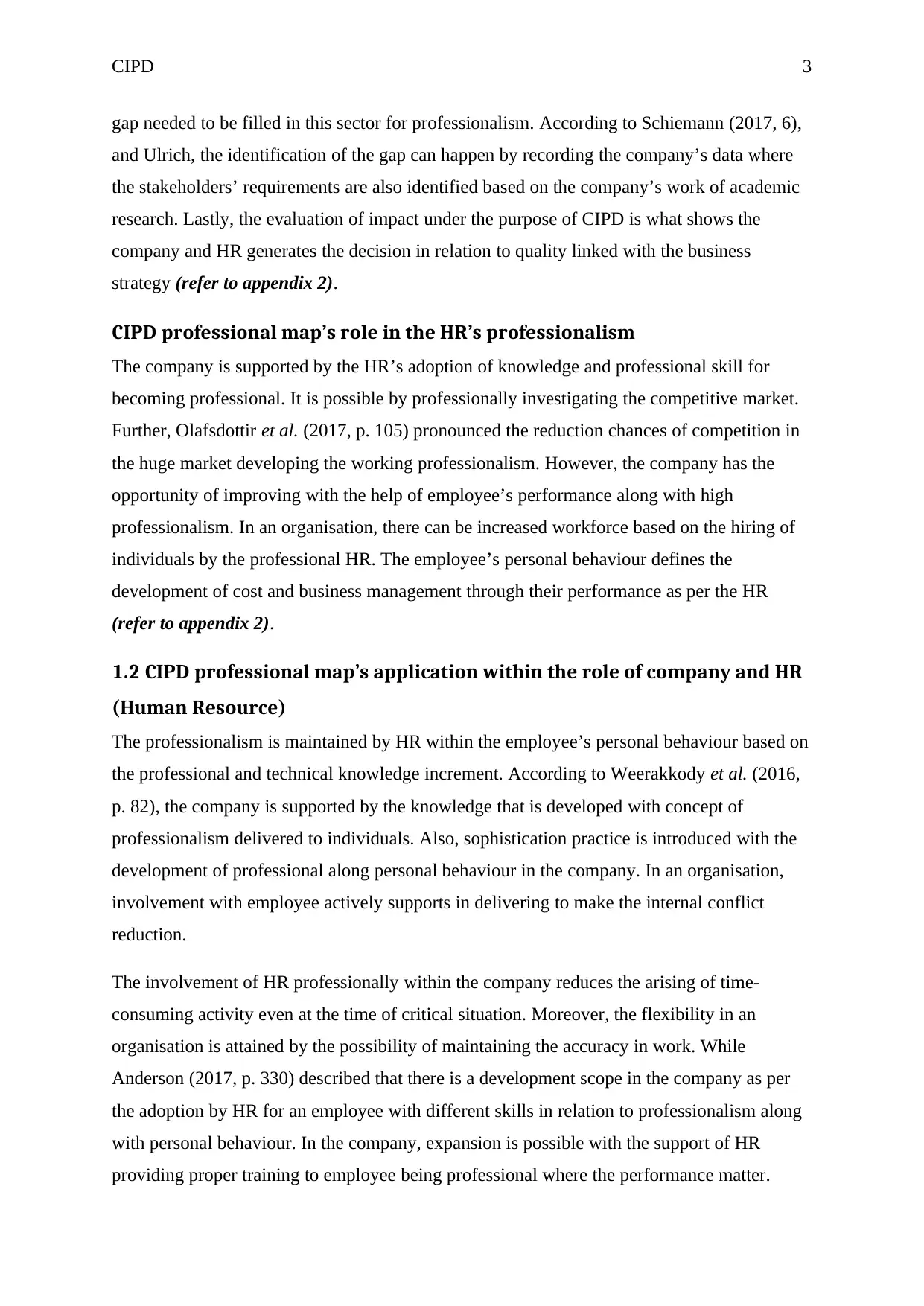
CIPD 3
gap needed to be filled in this sector for professionalism. According to Schiemann (2017, 6),
and Ulrich, the identification of the gap can happen by recording the company’s data where
the stakeholders’ requirements are also identified based on the company’s work of academic
research. Lastly, the evaluation of impact under the purpose of CIPD is what shows the
company and HR generates the decision in relation to quality linked with the business
strategy (refer to appendix 2).
CIPD professional map’s role in the HR’s professionalism
The company is supported by the HR’s adoption of knowledge and professional skill for
becoming professional. It is possible by professionally investigating the competitive market.
Further, Olafsdottir et al. (2017, p. 105) pronounced the reduction chances of competition in
the huge market developing the working professionalism. However, the company has the
opportunity of improving with the help of employee’s performance along with high
professionalism. In an organisation, there can be increased workforce based on the hiring of
individuals by the professional HR. The employee’s personal behaviour defines the
development of cost and business management through their performance as per the HR
(refer to appendix 2).
1.2 CIPD professional map’s application within the role of company and HR
(Human Resource)
The professionalism is maintained by HR within the employee’s personal behaviour based on
the professional and technical knowledge increment. According to Weerakkody et al. (2016,
p. 82), the company is supported by the knowledge that is developed with concept of
professionalism delivered to individuals. Also, sophistication practice is introduced with the
development of professional along personal behaviour in the company. In an organisation,
involvement with employee actively supports in delivering to make the internal conflict
reduction.
The involvement of HR professionally within the company reduces the arising of time-
consuming activity even at the time of critical situation. Moreover, the flexibility in an
organisation is attained by the possibility of maintaining the accuracy in work. While
Anderson (2017, p. 330) described that there is a development scope in the company as per
the adoption by HR for an employee with different skills in relation to professionalism along
with personal behaviour. In the company, expansion is possible with the support of HR
providing proper training to employee being professional where the performance matter.
gap needed to be filled in this sector for professionalism. According to Schiemann (2017, 6),
and Ulrich, the identification of the gap can happen by recording the company’s data where
the stakeholders’ requirements are also identified based on the company’s work of academic
research. Lastly, the evaluation of impact under the purpose of CIPD is what shows the
company and HR generates the decision in relation to quality linked with the business
strategy (refer to appendix 2).
CIPD professional map’s role in the HR’s professionalism
The company is supported by the HR’s adoption of knowledge and professional skill for
becoming professional. It is possible by professionally investigating the competitive market.
Further, Olafsdottir et al. (2017, p. 105) pronounced the reduction chances of competition in
the huge market developing the working professionalism. However, the company has the
opportunity of improving with the help of employee’s performance along with high
professionalism. In an organisation, there can be increased workforce based on the hiring of
individuals by the professional HR. The employee’s personal behaviour defines the
development of cost and business management through their performance as per the HR
(refer to appendix 2).
1.2 CIPD professional map’s application within the role of company and HR
(Human Resource)
The professionalism is maintained by HR within the employee’s personal behaviour based on
the professional and technical knowledge increment. According to Weerakkody et al. (2016,
p. 82), the company is supported by the knowledge that is developed with concept of
professionalism delivered to individuals. Also, sophistication practice is introduced with the
development of professional along personal behaviour in the company. In an organisation,
involvement with employee actively supports in delivering to make the internal conflict
reduction.
The involvement of HR professionally within the company reduces the arising of time-
consuming activity even at the time of critical situation. Moreover, the flexibility in an
organisation is attained by the possibility of maintaining the accuracy in work. While
Anderson (2017, p. 330) described that there is a development scope in the company as per
the adoption by HR for an employee with different skills in relation to professionalism along
with personal behaviour. In the company, expansion is possible with the support of HR
providing proper training to employee being professional where the performance matter.
Paraphrase This Document
Need a fresh take? Get an instant paraphrase of this document with our AI Paraphraser
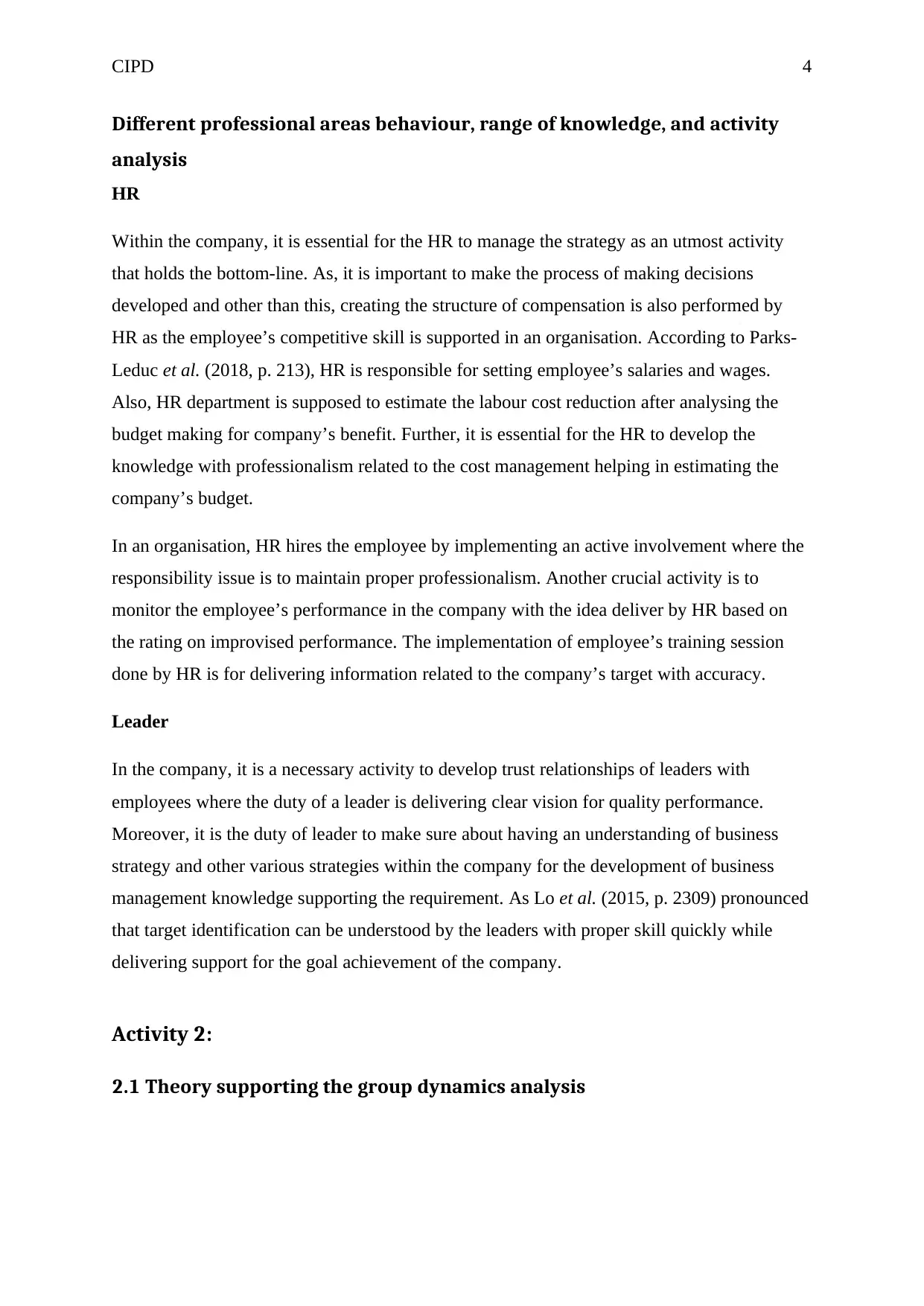
CIPD 4
Different professional areas behaviour, range of knowledge, and activity
analysis
HR
Within the company, it is essential for the HR to manage the strategy as an utmost activity
that holds the bottom-line. As, it is important to make the process of making decisions
developed and other than this, creating the structure of compensation is also performed by
HR as the employee’s competitive skill is supported in an organisation. According to Parks-
Leduc et al. (2018, p. 213), HR is responsible for setting employee’s salaries and wages.
Also, HR department is supposed to estimate the labour cost reduction after analysing the
budget making for company’s benefit. Further, it is essential for the HR to develop the
knowledge with professionalism related to the cost management helping in estimating the
company’s budget.
In an organisation, HR hires the employee by implementing an active involvement where the
responsibility issue is to maintain proper professionalism. Another crucial activity is to
monitor the employee’s performance in the company with the idea deliver by HR based on
the rating on improvised performance. The implementation of employee’s training session
done by HR is for delivering information related to the company’s target with accuracy.
Leader
In the company, it is a necessary activity to develop trust relationships of leaders with
employees where the duty of a leader is delivering clear vision for quality performance.
Moreover, it is the duty of leader to make sure about having an understanding of business
strategy and other various strategies within the company for the development of business
management knowledge supporting the requirement. As Lo et al. (2015, p. 2309) pronounced
that target identification can be understood by the leaders with proper skill quickly while
delivering support for the goal achievement of the company.
Activity 2:
2.1 Theory supporting the group dynamics analysis
Different professional areas behaviour, range of knowledge, and activity
analysis
HR
Within the company, it is essential for the HR to manage the strategy as an utmost activity
that holds the bottom-line. As, it is important to make the process of making decisions
developed and other than this, creating the structure of compensation is also performed by
HR as the employee’s competitive skill is supported in an organisation. According to Parks-
Leduc et al. (2018, p. 213), HR is responsible for setting employee’s salaries and wages.
Also, HR department is supposed to estimate the labour cost reduction after analysing the
budget making for company’s benefit. Further, it is essential for the HR to develop the
knowledge with professionalism related to the cost management helping in estimating the
company’s budget.
In an organisation, HR hires the employee by implementing an active involvement where the
responsibility issue is to maintain proper professionalism. Another crucial activity is to
monitor the employee’s performance in the company with the idea deliver by HR based on
the rating on improvised performance. The implementation of employee’s training session
done by HR is for delivering information related to the company’s target with accuracy.
Leader
In the company, it is a necessary activity to develop trust relationships of leaders with
employees where the duty of a leader is delivering clear vision for quality performance.
Moreover, it is the duty of leader to make sure about having an understanding of business
strategy and other various strategies within the company for the development of business
management knowledge supporting the requirement. As Lo et al. (2015, p. 2309) pronounced
that target identification can be understood by the leaders with proper skill quickly while
delivering support for the goal achievement of the company.
Activity 2:
2.1 Theory supporting the group dynamics analysis
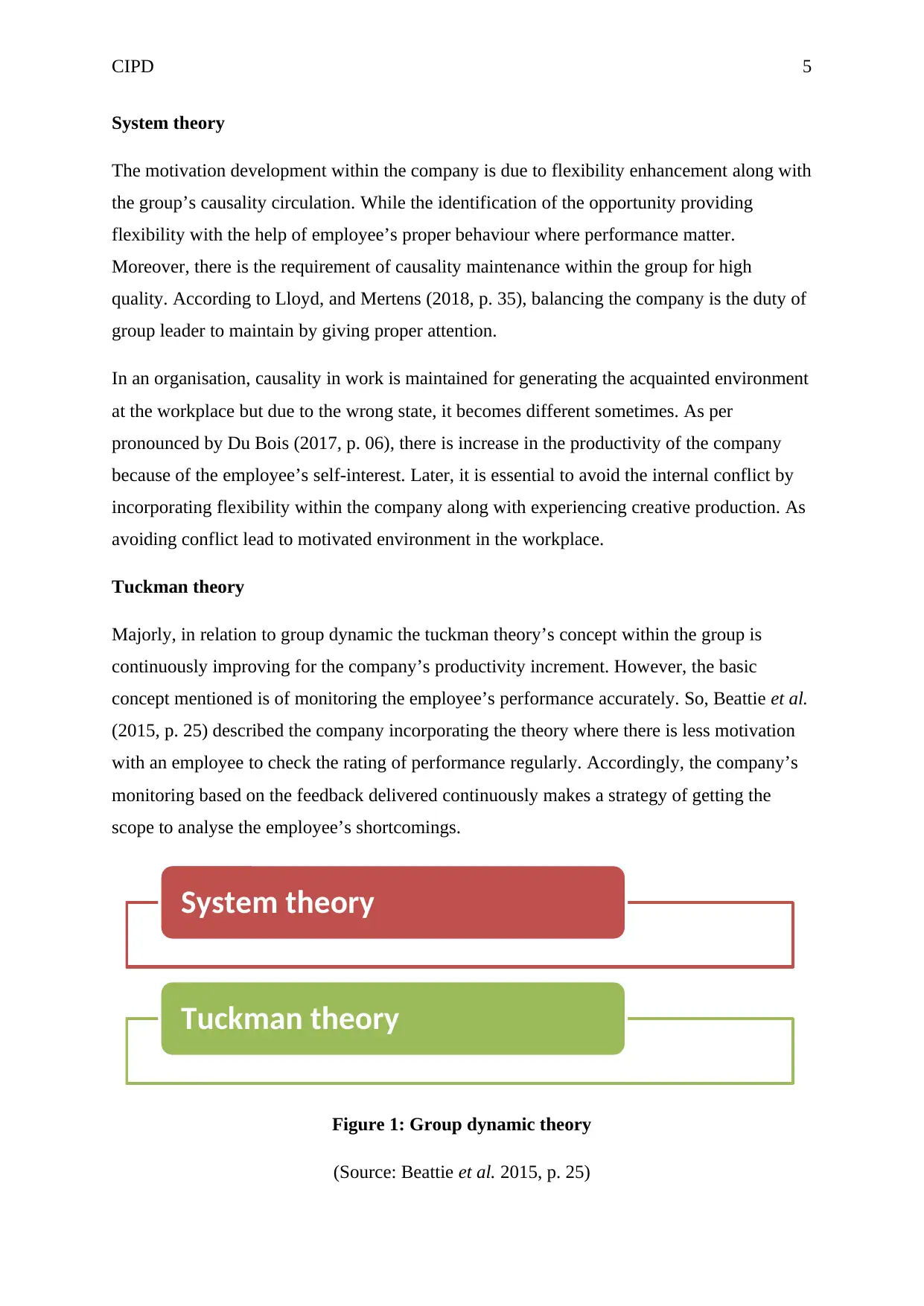
CIPD 5
System theory
The motivation development within the company is due to flexibility enhancement along with
the group’s causality circulation. While the identification of the opportunity providing
flexibility with the help of employee’s proper behaviour where performance matter.
Moreover, there is the requirement of causality maintenance within the group for high
quality. According to Lloyd, and Mertens (2018, p. 35), balancing the company is the duty of
group leader to maintain by giving proper attention.
In an organisation, causality in work is maintained for generating the acquainted environment
at the workplace but due to the wrong state, it becomes different sometimes. As per
pronounced by Du Bois (2017, p. 06), there is increase in the productivity of the company
because of the employee’s self-interest. Later, it is essential to avoid the internal conflict by
incorporating flexibility within the company along with experiencing creative production. As
avoiding conflict lead to motivated environment in the workplace.
Tuckman theory
Majorly, in relation to group dynamic the tuckman theory’s concept within the group is
continuously improving for the company’s productivity increment. However, the basic
concept mentioned is of monitoring the employee’s performance accurately. So, Beattie et al.
(2015, p. 25) described the company incorporating the theory where there is less motivation
with an employee to check the rating of performance regularly. Accordingly, the company’s
monitoring based on the feedback delivered continuously makes a strategy of getting the
scope to analyse the employee’s shortcomings.
Figure 1: Group dynamic theory
(Source: Beattie et al. 2015, p. 25)
System theory
Tuckman theory
System theory
The motivation development within the company is due to flexibility enhancement along with
the group’s causality circulation. While the identification of the opportunity providing
flexibility with the help of employee’s proper behaviour where performance matter.
Moreover, there is the requirement of causality maintenance within the group for high
quality. According to Lloyd, and Mertens (2018, p. 35), balancing the company is the duty of
group leader to maintain by giving proper attention.
In an organisation, causality in work is maintained for generating the acquainted environment
at the workplace but due to the wrong state, it becomes different sometimes. As per
pronounced by Du Bois (2017, p. 06), there is increase in the productivity of the company
because of the employee’s self-interest. Later, it is essential to avoid the internal conflict by
incorporating flexibility within the company along with experiencing creative production. As
avoiding conflict lead to motivated environment in the workplace.
Tuckman theory
Majorly, in relation to group dynamic the tuckman theory’s concept within the group is
continuously improving for the company’s productivity increment. However, the basic
concept mentioned is of monitoring the employee’s performance accurately. So, Beattie et al.
(2015, p. 25) described the company incorporating the theory where there is less motivation
with an employee to check the rating of performance regularly. Accordingly, the company’s
monitoring based on the feedback delivered continuously makes a strategy of getting the
scope to analyse the employee’s shortcomings.
Figure 1: Group dynamic theory
(Source: Beattie et al. 2015, p. 25)
System theory
Tuckman theory
⊘ This is a preview!⊘
Do you want full access?
Subscribe today to unlock all pages.

Trusted by 1+ million students worldwide
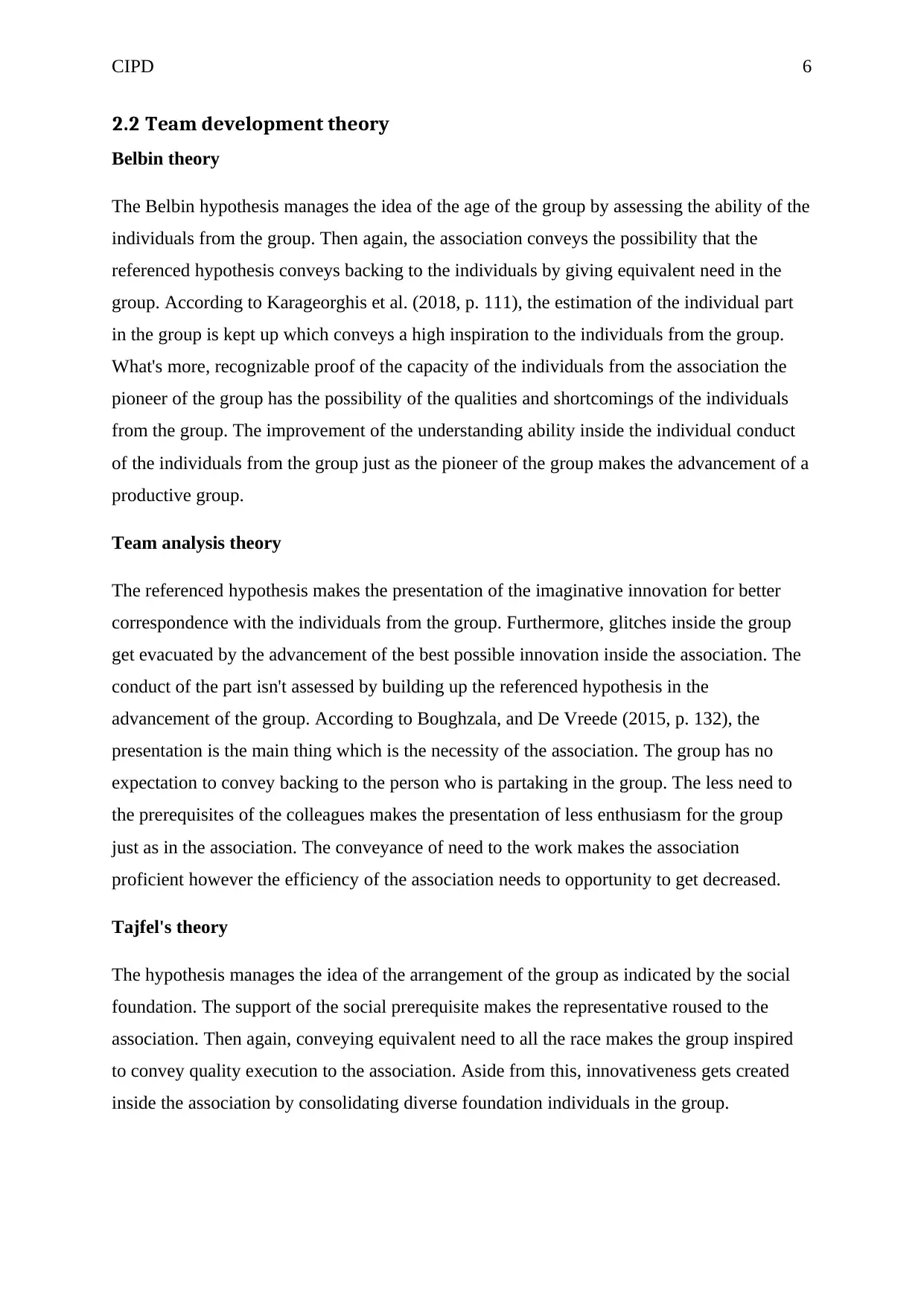
CIPD 6
2.2 Team development theory
Belbin theory
The Belbin hypothesis manages the idea of the age of the group by assessing the ability of the
individuals from the group. Then again, the association conveys the possibility that the
referenced hypothesis conveys backing to the individuals by giving equivalent need in the
group. According to Karageorghis et al. (2018, p. 111), the estimation of the individual part
in the group is kept up which conveys a high inspiration to the individuals from the group.
What's more, recognizable proof of the capacity of the individuals from the association the
pioneer of the group has the possibility of the qualities and shortcomings of the individuals
from the group. The improvement of the understanding ability inside the individual conduct
of the individuals from the group just as the pioneer of the group makes the advancement of a
productive group.
Team analysis theory
The referenced hypothesis makes the presentation of the imaginative innovation for better
correspondence with the individuals from the group. Furthermore, glitches inside the group
get evacuated by the advancement of the best possible innovation inside the association. The
conduct of the part isn't assessed by building up the referenced hypothesis in the
advancement of the group. According to Boughzala, and De Vreede (2015, p. 132), the
presentation is the main thing which is the necessity of the association. The group has no
expectation to convey backing to the person who is partaking in the group. The less need to
the prerequisites of the colleagues makes the presentation of less enthusiasm for the group
just as in the association. The conveyance of need to the work makes the association
proficient however the efficiency of the association needs to opportunity to get decreased.
Tajfel's theory
The hypothesis manages the idea of the arrangement of the group as indicated by the social
foundation. The support of the social prerequisite makes the representative roused to the
association. Then again, conveying equivalent need to all the race makes the group inspired
to convey quality execution to the association. Aside from this, innovativeness gets created
inside the association by consolidating diverse foundation individuals in the group.
2.2 Team development theory
Belbin theory
The Belbin hypothesis manages the idea of the age of the group by assessing the ability of the
individuals from the group. Then again, the association conveys the possibility that the
referenced hypothesis conveys backing to the individuals by giving equivalent need in the
group. According to Karageorghis et al. (2018, p. 111), the estimation of the individual part
in the group is kept up which conveys a high inspiration to the individuals from the group.
What's more, recognizable proof of the capacity of the individuals from the association the
pioneer of the group has the possibility of the qualities and shortcomings of the individuals
from the group. The improvement of the understanding ability inside the individual conduct
of the individuals from the group just as the pioneer of the group makes the advancement of a
productive group.
Team analysis theory
The referenced hypothesis makes the presentation of the imaginative innovation for better
correspondence with the individuals from the group. Furthermore, glitches inside the group
get evacuated by the advancement of the best possible innovation inside the association. The
conduct of the part isn't assessed by building up the referenced hypothesis in the
advancement of the group. According to Boughzala, and De Vreede (2015, p. 132), the
presentation is the main thing which is the necessity of the association. The group has no
expectation to convey backing to the person who is partaking in the group. The less need to
the prerequisites of the colleagues makes the presentation of less enthusiasm for the group
just as in the association. The conveyance of need to the work makes the association
proficient however the efficiency of the association needs to opportunity to get decreased.
Tajfel's theory
The hypothesis manages the idea of the arrangement of the group as indicated by the social
foundation. The support of the social prerequisite makes the representative roused to the
association. Then again, conveying equivalent need to all the race makes the group inspired
to convey quality execution to the association. Aside from this, innovativeness gets created
inside the association by consolidating diverse foundation individuals in the group.
Paraphrase This Document
Need a fresh take? Get an instant paraphrase of this document with our AI Paraphraser
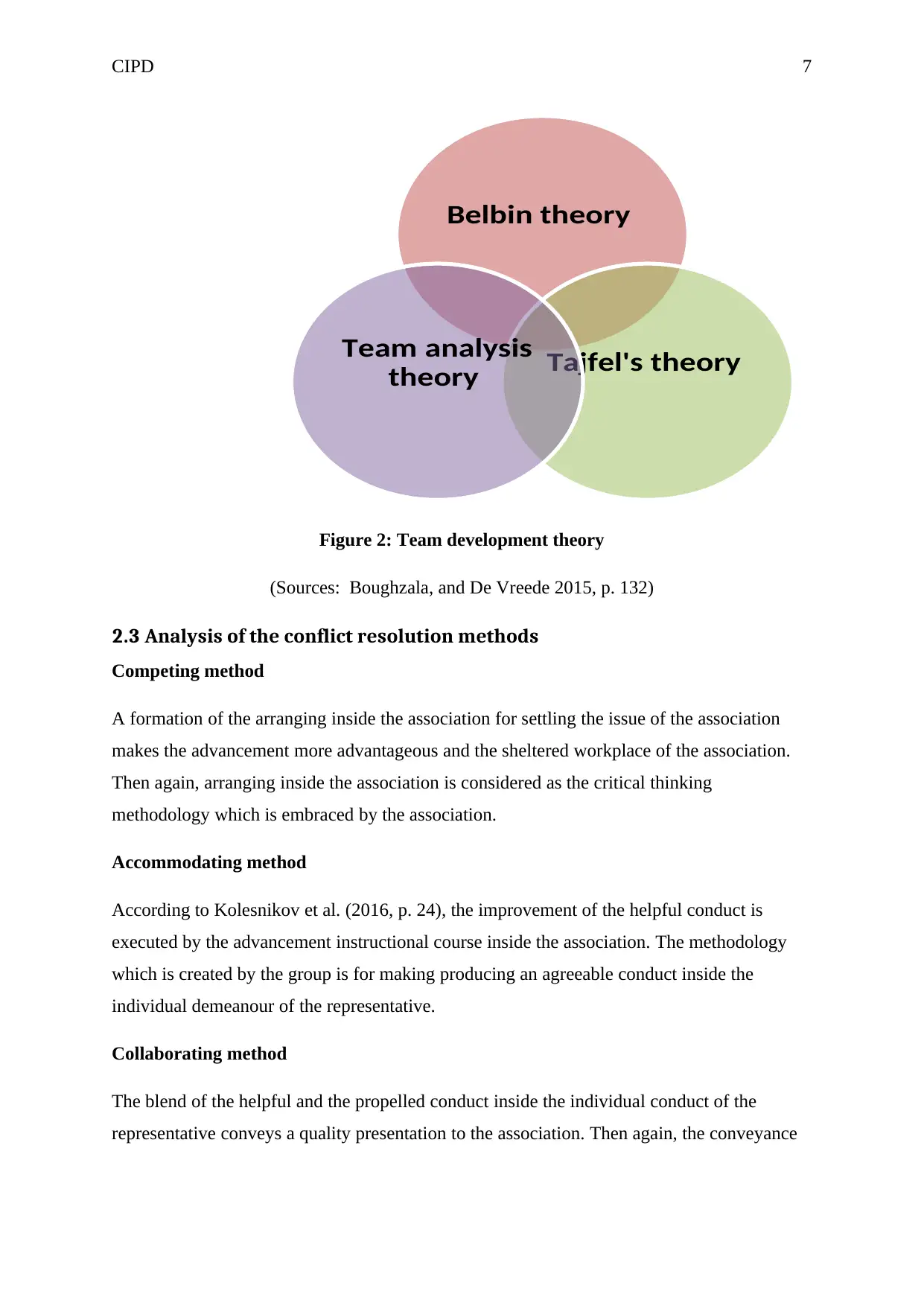
CIPD 7
Figure 2: Team development theory
(Sources: Boughzala, and De Vreede 2015, p. 132)
2.3 Analysis of the conflict resolution methods
Competing method
A formation of the arranging inside the association for settling the issue of the association
makes the advancement more advantageous and the sheltered workplace of the association.
Then again, arranging inside the association is considered as the critical thinking
methodology which is embraced by the association.
Accommodating method
According to Kolesnіkov et al. (2016, p. 24), the improvement of the helpful conduct is
executed by the advancement instructional course inside the association. The methodology
which is created by the group is for making producing an agreeable conduct inside the
individual demeanour of the representative.
Collaborating method
The blend of the helpful and the propelled conduct inside the individual conduct of the
representative conveys a quality presentation to the association. Then again, the conveyance
Belbin theory
Tajfel's theory
Team analysis
theory
Figure 2: Team development theory
(Sources: Boughzala, and De Vreede 2015, p. 132)
2.3 Analysis of the conflict resolution methods
Competing method
A formation of the arranging inside the association for settling the issue of the association
makes the advancement more advantageous and the sheltered workplace of the association.
Then again, arranging inside the association is considered as the critical thinking
methodology which is embraced by the association.
Accommodating method
According to Kolesnіkov et al. (2016, p. 24), the improvement of the helpful conduct is
executed by the advancement instructional course inside the association. The methodology
which is created by the group is for making producing an agreeable conduct inside the
individual demeanour of the representative.
Collaborating method
The blend of the helpful and the propelled conduct inside the individual conduct of the
representative conveys a quality presentation to the association. Then again, the conveyance
Belbin theory
Tajfel's theory
Team analysis
theory
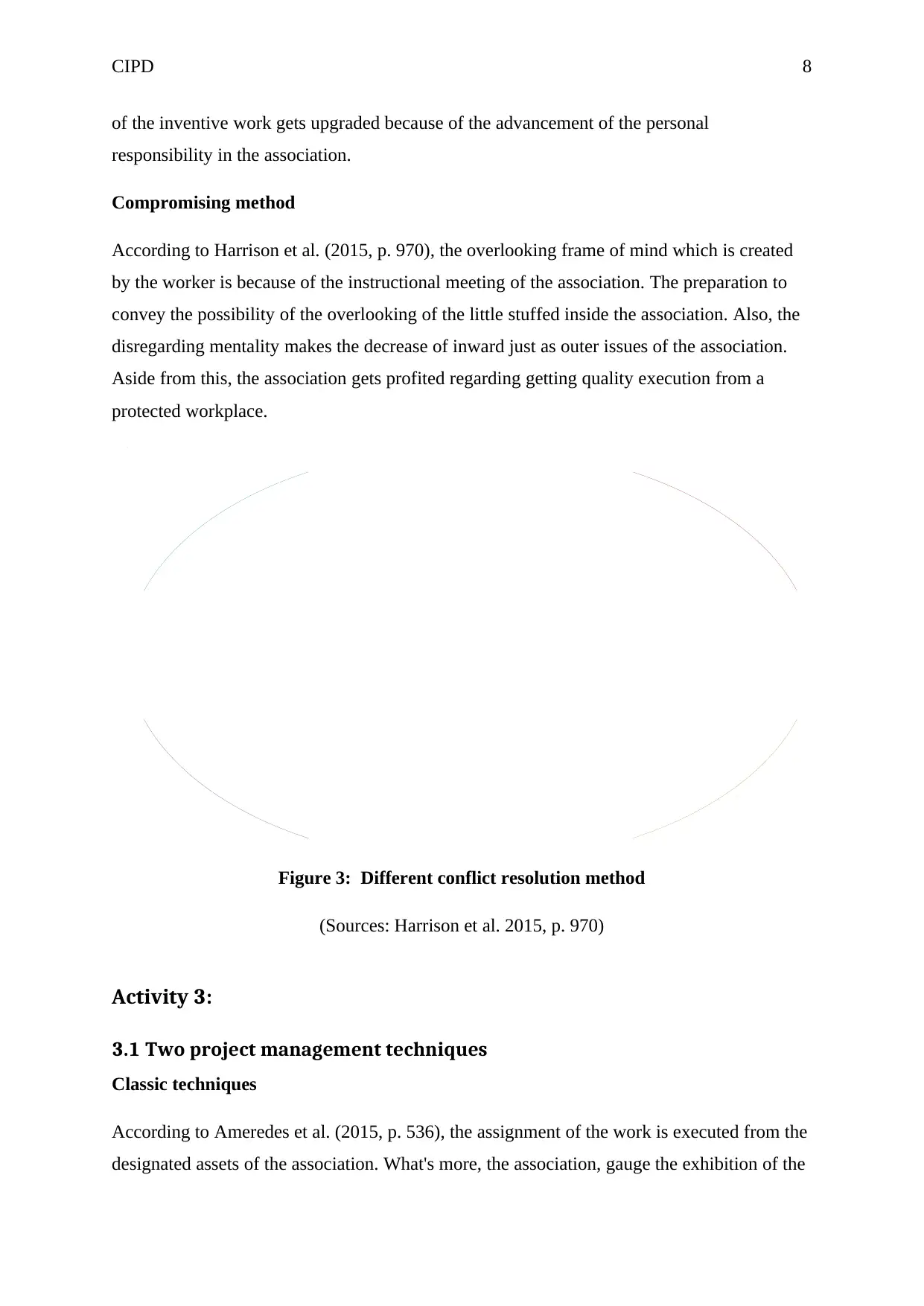
CIPD 8
of the inventive work gets upgraded because of the advancement of the personal
responsibility in the association.
Compromising method
According to Harrison et al. (2015, p. 970), the overlooking frame of mind which is created
by the worker is because of the instructional meeting of the association. The preparation to
convey the possibility of the overlooking of the little stuffed inside the association. Also, the
disregarding mentality makes the decrease of inward just as outer issues of the association.
Aside from this, the association gets profited regarding getting quality execution from a
protected workplace.
Figure 3: Different conflict resolution method
(Sources: Harrison et al. 2015, p. 970)
Activity 3:
3.1 Two project management techniques
Classic techniques
According to Ameredes et al. (2015, p. 536), the assignment of the work is executed from the
designated assets of the association. What's more, the association, gauge the exhibition of the
CompetingmethodAccommodatingmethodCollaboratingmethodCompromisingmethod
of the inventive work gets upgraded because of the advancement of the personal
responsibility in the association.
Compromising method
According to Harrison et al. (2015, p. 970), the overlooking frame of mind which is created
by the worker is because of the instructional meeting of the association. The preparation to
convey the possibility of the overlooking of the little stuffed inside the association. Also, the
disregarding mentality makes the decrease of inward just as outer issues of the association.
Aside from this, the association gets profited regarding getting quality execution from a
protected workplace.
Figure 3: Different conflict resolution method
(Sources: Harrison et al. 2015, p. 970)
Activity 3:
3.1 Two project management techniques
Classic techniques
According to Ameredes et al. (2015, p. 536), the assignment of the work is executed from the
designated assets of the association. What's more, the association, gauge the exhibition of the
CompetingmethodAccommodatingmethodCollaboratingmethodCompromisingmethod
⊘ This is a preview!⊘
Do you want full access?
Subscribe today to unlock all pages.

Trusted by 1+ million students worldwide
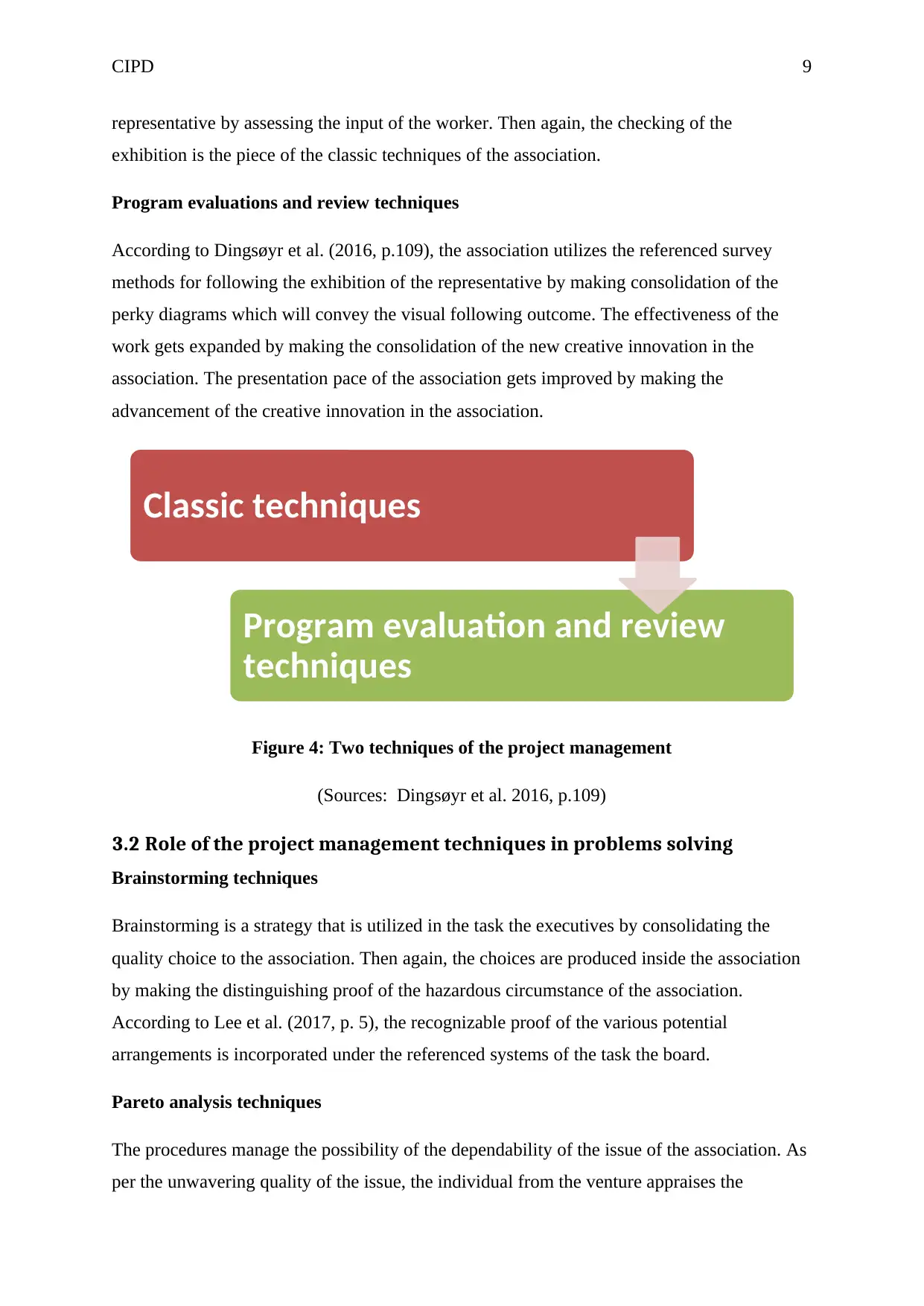
CIPD 9
representative by assessing the input of the worker. Then again, the checking of the
exhibition is the piece of the classic techniques of the association.
Program evaluations and review techniques
According to Dingsøyr et al. (2016, p.109), the association utilizes the referenced survey
methods for following the exhibition of the representative by making consolidation of the
perky diagrams which will convey the visual following outcome. The effectiveness of the
work gets expanded by making the consolidation of the new creative innovation in the
association. The presentation pace of the association gets improved by making the
advancement of the creative innovation in the association.
Figure 4: Two techniques of the project management
(Sources: Dingsøyr et al. 2016, p.109)
3.2 Role of the project management techniques in problems solving
Brainstorming techniques
Brainstorming is a strategy that is utilized in the task the executives by consolidating the
quality choice to the association. Then again, the choices are produced inside the association
by making the distinguishing proof of the hazardous circumstance of the association.
According to Lee et al. (2017, p. 5), the recognizable proof of the various potential
arrangements is incorporated under the referenced systems of the task the board.
Pareto analysis techniques
The procedures manage the possibility of the dependability of the issue of the association. As
per the unwavering quality of the issue, the individual from the venture appraises the
Classic techniques
Program evaluation and review
techniques
representative by assessing the input of the worker. Then again, the checking of the
exhibition is the piece of the classic techniques of the association.
Program evaluations and review techniques
According to Dingsøyr et al. (2016, p.109), the association utilizes the referenced survey
methods for following the exhibition of the representative by making consolidation of the
perky diagrams which will convey the visual following outcome. The effectiveness of the
work gets expanded by making the consolidation of the new creative innovation in the
association. The presentation pace of the association gets improved by making the
advancement of the creative innovation in the association.
Figure 4: Two techniques of the project management
(Sources: Dingsøyr et al. 2016, p.109)
3.2 Role of the project management techniques in problems solving
Brainstorming techniques
Brainstorming is a strategy that is utilized in the task the executives by consolidating the
quality choice to the association. Then again, the choices are produced inside the association
by making the distinguishing proof of the hazardous circumstance of the association.
According to Lee et al. (2017, p. 5), the recognizable proof of the various potential
arrangements is incorporated under the referenced systems of the task the board.
Pareto analysis techniques
The procedures manage the possibility of the dependability of the issue of the association. As
per the unwavering quality of the issue, the individual from the venture appraises the
Classic techniques
Program evaluation and review
techniques
Paraphrase This Document
Need a fresh take? Get an instant paraphrase of this document with our AI Paraphraser
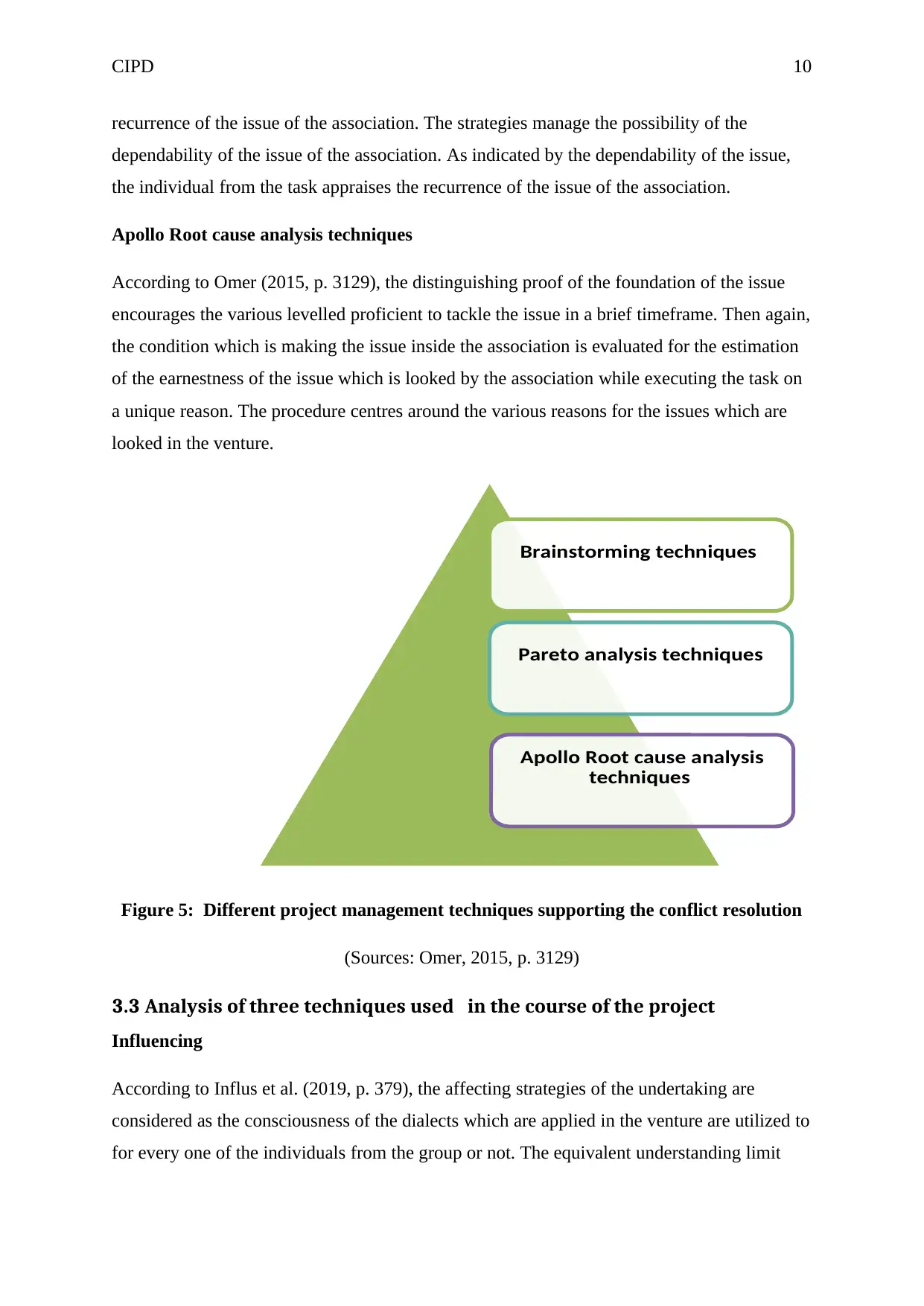
CIPD 10
recurrence of the issue of the association. The strategies manage the possibility of the
dependability of the issue of the association. As indicated by the dependability of the issue,
the individual from the task appraises the recurrence of the issue of the association.
Apollo Root cause analysis techniques
According to Omer (2015, p. 3129), the distinguishing proof of the foundation of the issue
encourages the various levelled proficient to tackle the issue in a brief timeframe. Then again,
the condition which is making the issue inside the association is evaluated for the estimation
of the earnestness of the issue which is looked by the association while executing the task on
a unique reason. The procedure centres around the various reasons for the issues which are
looked in the venture.
Figure 5: Different project management techniques supporting the conflict resolution
(Sources: Omer, 2015, p. 3129)
3.3 Analysis of three techniques used in the course of the project
Influencing
According to Influs et al. (2019, p. 379), the affecting strategies of the undertaking are
considered as the consciousness of the dialects which are applied in the venture are utilized to
for every one of the individuals from the group or not. The equivalent understanding limit
Brainstorming techniques
Pareto analysis techniques
Apollo Root cause analysis
techniques
recurrence of the issue of the association. The strategies manage the possibility of the
dependability of the issue of the association. As indicated by the dependability of the issue,
the individual from the task appraises the recurrence of the issue of the association.
Apollo Root cause analysis techniques
According to Omer (2015, p. 3129), the distinguishing proof of the foundation of the issue
encourages the various levelled proficient to tackle the issue in a brief timeframe. Then again,
the condition which is making the issue inside the association is evaluated for the estimation
of the earnestness of the issue which is looked by the association while executing the task on
a unique reason. The procedure centres around the various reasons for the issues which are
looked in the venture.
Figure 5: Different project management techniques supporting the conflict resolution
(Sources: Omer, 2015, p. 3129)
3.3 Analysis of three techniques used in the course of the project
Influencing
According to Influs et al. (2019, p. 379), the affecting strategies of the undertaking are
considered as the consciousness of the dialects which are applied in the venture are utilized to
for every one of the individuals from the group or not. The equivalent understanding limit
Brainstorming techniques
Pareto analysis techniques
Apollo Root cause analysis
techniques
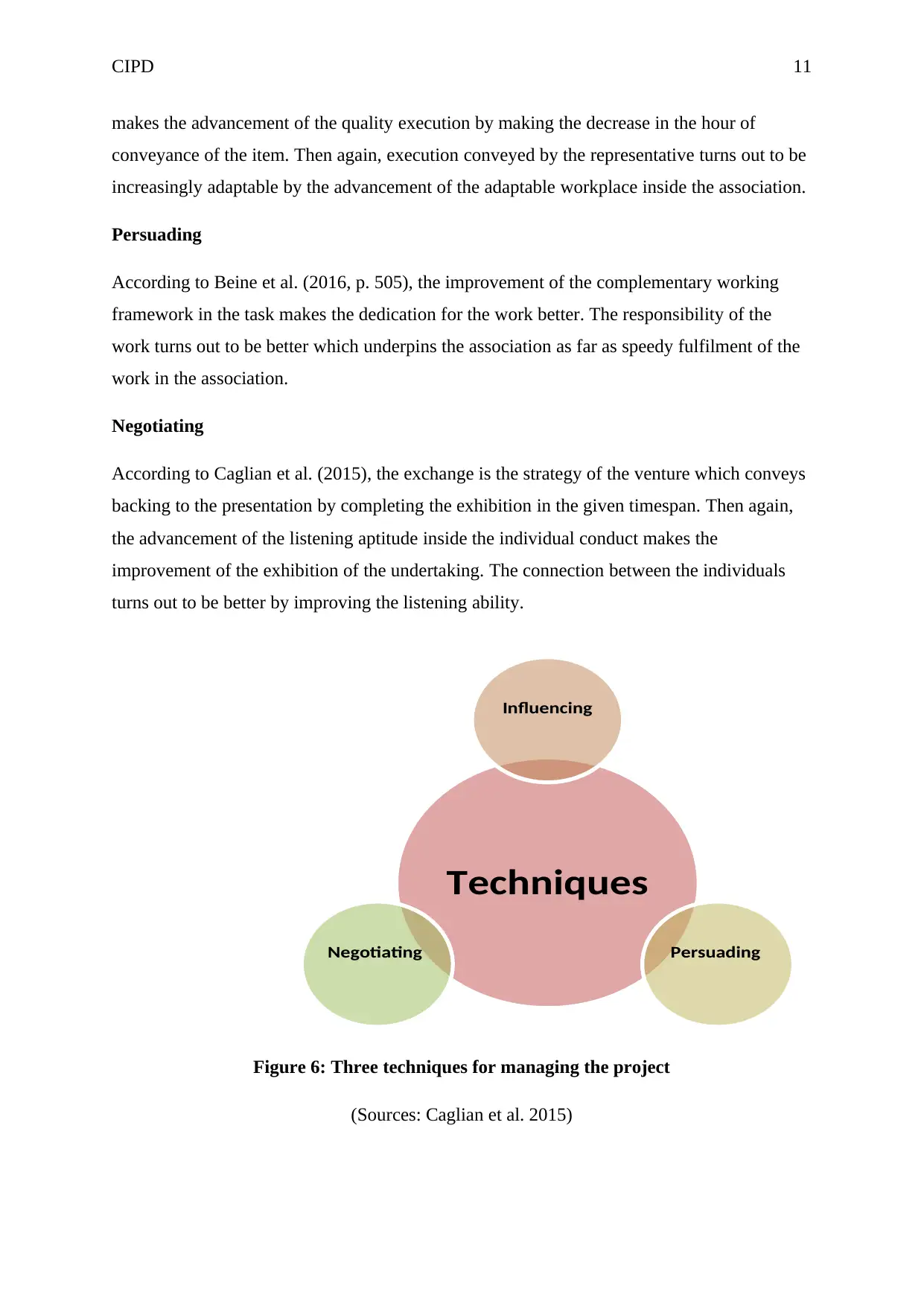
CIPD 11
makes the advancement of the quality execution by making the decrease in the hour of
conveyance of the item. Then again, execution conveyed by the representative turns out to be
increasingly adaptable by the advancement of the adaptable workplace inside the association.
Persuading
According to Beine et al. (2016, p. 505), the improvement of the complementary working
framework in the task makes the dedication for the work better. The responsibility of the
work turns out to be better which underpins the association as far as speedy fulfilment of the
work in the association.
Negotiating
According to Caglian et al. (2015), the exchange is the strategy of the venture which conveys
backing to the presentation by completing the exhibition in the given timespan. Then again,
the advancement of the listening aptitude inside the individual conduct makes the
improvement of the exhibition of the undertaking. The connection between the individuals
turns out to be better by improving the listening ability.
Figure 6: Three techniques for managing the project
(Sources: Caglian et al. 2015)
Techniques
Influencing
PersuadingNegotiating
makes the advancement of the quality execution by making the decrease in the hour of
conveyance of the item. Then again, execution conveyed by the representative turns out to be
increasingly adaptable by the advancement of the adaptable workplace inside the association.
Persuading
According to Beine et al. (2016, p. 505), the improvement of the complementary working
framework in the task makes the dedication for the work better. The responsibility of the
work turns out to be better which underpins the association as far as speedy fulfilment of the
work in the association.
Negotiating
According to Caglian et al. (2015), the exchange is the strategy of the venture which conveys
backing to the presentation by completing the exhibition in the given timespan. Then again,
the advancement of the listening aptitude inside the individual conduct makes the
improvement of the exhibition of the undertaking. The connection between the individuals
turns out to be better by improving the listening ability.
Figure 6: Three techniques for managing the project
(Sources: Caglian et al. 2015)
Techniques
Influencing
PersuadingNegotiating
⊘ This is a preview!⊘
Do you want full access?
Subscribe today to unlock all pages.

Trusted by 1+ million students worldwide
1 out of 18
Related Documents
Your All-in-One AI-Powered Toolkit for Academic Success.
+13062052269
info@desklib.com
Available 24*7 on WhatsApp / Email
![[object Object]](/_next/static/media/star-bottom.7253800d.svg)
Unlock your academic potential
Copyright © 2020–2025 A2Z Services. All Rights Reserved. Developed and managed by ZUCOL.





